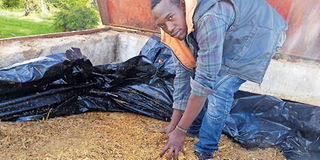How to tell good from bad silage

The colour of silage can vary depending on the material ensiled but light green to green brown or golden in colour are normal ranges for grass, cereal and maize silages. FILE PHOTO | NMG
What you need to know:
- Without the laboratory test, silage is judged as good or bad using simple subjective criteria such as physical appearance and texture, colour and aroma.
- It is strongly recommended not to taste the silage as poorly preserved feed may have undesirable bacteria, yeasts and moulds.
- Presence of moulds mean inadequate compaction or penetration of air during preservation or storage. If you can easily squeeze moisture out of the silage, it implies the ensiled forage had very low dry matter presenting a high risk of poor fermentation and significant losses in terms of quality and quantity.
- The aroma desired from silage is mild, pleasantly acidic. Fermented silage has offensive taste and smell that is strong, pungent and very unpleasant with ammonia. Smell of tobacco with burnt sugar flavour denotes the silage overheated during fermentation process.
It is another time of the year when most farmers are feeding their dairy cows silage and other feeds in the reserve like hay as the dry spell bites.
While silage is a nutritious feed, most farmers give it to their animals straight from the bunker before testing the quality.
Analysing silage for its basic qualities at the farm level is the best starting point. Laboratory nutrient analysis gives more objective silage assessment.
The analysis shows the intake potential, the value of the feed to the animals, it identifies possible problems or health impacts on the cow and allows the farmer to reflect on possible causes of unsatisfactory quality.
Put it in another way, the results offer the farmer a chance to learn from mistakes and make informed decisions when making subsequent silage for better quality.
Without the laboratory test, silage is judged as good or bad using simple subjective criteria such as physical appearance and texture, colour and aroma.
Physical characteristics like smell, texture and colour can be used but evaluating pH and fermentation acids gives better feedback.
It is strongly recommended not to taste the silage as poorly preserved feed may have undesirable bacteria, yeasts and moulds.
The pH is used to tell the amount of acid in silage. Silage with a pH of 3.5-4.2 indicates excellent fresh acidic/sweet silage, 4.2-4.5 is good acidic, 4.5-5.0 fair less acidic and above 5.0 poor pungent/rancid smelling silage.
High pH is sometimes caused by high dry matter, incomplete fermentation process, opening or sampling too early, poor packing, presence of moulds and or manure in the silage.
Better quality silage has low acetic acid (1-3 per cent), butyric and high in lactic (4-7 per cent) and sugars. Lactic acid is responsible for most of the drop in pH of the silage, which is desirable although very high levels are associated with acidosis-type problems.
On the other hand, high levels of acetic acid and production of butyric acid indicates poorly fermented silage sometimes due to lose packing or very wet silage and this leads to low intake.
Silage of poor quality has slimy soft texture when rubbed from the fibre or leaf and contains moulds. Very dry or even brittle (breaking like biscuit) silage shows the material ensiled had too high dry matter content and there was overheating during storage causing much deterioration.
IDEAL COLOUR OF SILAGE
Leafy and more fibrous silage means low metabolisable energy and crude protein. Metabolisable energy is that energy available to an animal for metabolic processes, growth or reproduction after losses in dung and urine. Stemmy, fibrous silage with seed heads implies the crop was harvested too late.
Presence of moulds mean inadequate compaction or penetration of air during preservation or storage. If you can easily squeeze moisture out of the silage, it implies the ensiled forage had very low dry matter presenting a high risk of poor fermentation and significant losses in terms of quality and quantity.
The colour of silage can vary depending on the material ensiled but light green to green brown or golden in colour are normal ranges for grass, cereal and maize silages.
Black, slightly damp and dark brown colours indicate poor quality silage with extensive heat damage and significant losses in digestibility, usually accompanied by moulds. Heat damage occurs when temperatures are very high especially when the silo is not quickly filled or adequately packed, leaving excess oxygen in the silage.
This allows continuation of plant respiration for extended periods resulting in more heat production than is desired. At these higher temperatures, a chemical reaction occurs between protein and carbohydrate in the forage known as browning reaction, resulting to the dark brown colour and cured tobacco odour.
The aroma desired from silage is mild, pleasantly acidic. Fermented silage has offensive taste and smell that is strong, pungent and very unpleasant with ammonia. Smell of tobacco with burnt sugar flavour denotes the silage overheated during fermentation process.
An alcohol odour is associated with yeast fermentation arising from slow rates of feed outs and air penetration into the silage with high levels of ethanol. Sour vinegar smell shows poor fermentation process dominated by acetic acid producing bacteria and is common in low dry matter and low sugar ensiling material.
Silage acceptability to the animals and production performance is related to feed material ensiled, its nutrient content, digestibility, physical form, quality of fermentation and microbial quality, among others.
Silage of poor quality has low palatability, but the animals might end up eating after allowing some pungent smell to escape or after being mixed with additives such as molasses or fresh forages, but remember animals do not require feeds instead the nutrients in that feed. A farm adviser can also help do the basic silage quality analysis.
Opinya is based at Department of Animal Sciences, Egerton University.





